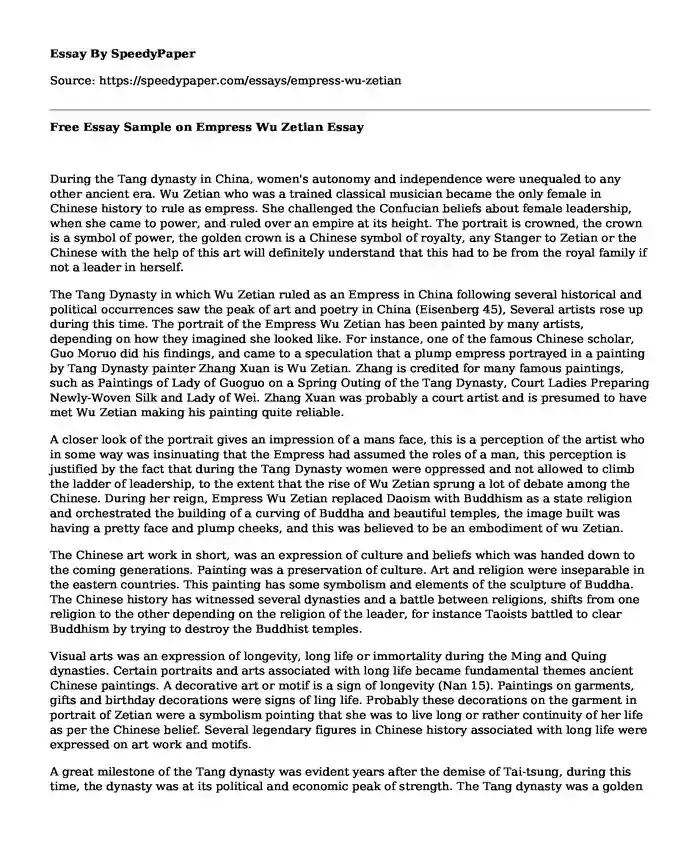
| Type of paper: | Essay |
| Categories: | History Personality |
| Pages: | 3 |
| Wordcount: | 732 words |
During the Tang dynasty in China, women's autonomy and independence were unequaled to any other ancient era. Wu Zetian who was a trained classical musician became the only female in Chinese history to rule as empress. She challenged the Confucian beliefs about female leadership, when she came to power, and ruled over an empire at its height. The portrait is crowned, the crown is a symbol of power, the golden crown is a Chinese symbol of royalty, any Stanger to Zetian or the Chinese with the help of this art will definitely understand that this had to be from the royal family if not a leader in herself.
The Tang Dynasty in which Wu Zetian ruled as an Empress in China following several historical and political occurrences saw the peak of art and poetry in China (Eisenberg 45), Several artists rose up during this time. The portrait of the Empress Wu Zetian has been painted by many artists, depending on how they imagined she looked like. For instance, one of the famous Chinese scholar, Guo Moruo did his findings, and came to a speculation that a plump empress portrayed in a painting by Tang Dynasty painter Zhang Xuan is Wu Zetian. Zhang is credited for many famous paintings, such as Paintings of Lady of Guoguo on a Spring Outing of the Tang Dynasty, Court Ladies Preparing Newly-Woven Silk and Lady of Wei. Zhang Xuan was probably a court artist and is presumed to have met Wu Zetian making his painting quite reliable.
A closer look of the portrait gives an impression of a mans face, this is a perception of the artist who in some way was insinuating that the Empress had assumed the roles of a man, this perception is justified by the fact that during the Tang Dynasty women were oppressed and not allowed to climb the ladder of leadership, to the extent that the rise of Wu Zetian sprung a lot of debate among the Chinese. During her reign, Empress Wu Zetian replaced Daoism with Buddhism as a state religion and orchestrated the building of a curving of Buddha and beautiful temples, the image built was having a pretty face and plump cheeks, and this was believed to be an embodiment of wu Zetian.
The Chinese art work in short, was an expression of culture and beliefs which was handed down to the coming generations. Painting was a preservation of culture. Art and religion were inseparable in the eastern countries. This painting has some symbolism and elements of the sculpture of Buddha. The Chinese history has witnessed several dynasties and a battle between religions, shifts from one religion to the other depending on the religion of the leader, for instance Taoists battled to clear Buddhism by trying to destroy the Buddhist temples.
Visual arts was an expression of longevity, long life or immortality during the Ming and Quing dynasties. Certain portraits and arts associated with long life became fundamental themes ancient Chinese paintings. A decorative art or motif is a sign of longevity (Nan 15). Paintings on garments, gifts and birthday decorations were signs of ling life. Probably these decorations on the garment in portrait of Zetian were a symbolism pointing that she was to live long or rather continuity of her life as per the Chinese belief. Several legendary figures in Chinese history associated with long life were expressed on art work and motifs.
A great milestone of the Tang dynasty was evident years after the demise of Tai-tsung, during this time, the dynasty was at its political and economic peak of strength. The Tang dynasty was a golden age of art and literature for the Chinese because of this peace and prosperity achieved (Nan 23). Poets became famous for the simplicity of their work. However, their autonomy and success did not last long because were deeply affected by the rebellion of northeastern troops against court officials in the capital city. Named after the leader of the rebel troops, the Rebellion caused massive loss of lives of thousands people, including some people of the royal family, and this marked the beginning of the end for the Tang dynasty.
Works Cited
Eisenberg, Andrew. "Emperor Gaozong, the Rise of Wu Zetian, And Factional Politics in the Early Tang." Tang Studies 2012.30 (2012): 45-69.
Nan, Guo. "Analysis of the image of Wu Zetian in junior middle school teaching materials." Chinese Education & Society 36.3 (2003): 34-42.
Cite this page
Free Essay Sample on Empress Wu Zetian. (2019, Oct 31). Retrieved from https://speedypaper.net/essays/empress-wu-zetian
Request Removal
If you are the original author of this essay and no longer wish to have it published on the SpeedyPaper website, please click below to request its removal:
- Freudian Defense Mechanism Essay Example
- Free Essay: Ways in Which Differences and Inequalities Persist Overtime
- Cyber Briefing Questions, Essay Sample
- Talking About a Student with Parents - Free Essay Example
- Free Essay Sample: Understanding Applications in the Aircraft Structure
- Literature Review Paper Sample: History Problems on England
- Institutional AffiliationPlastic Water Bottle Pollution
Popular categories




